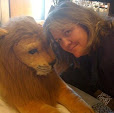Mercifully, I finished Gone to Earth
and sent it back to the library where it will gather dust until another poor soul is seduced into reading it. I'm overstating, of course, and I am glad I read it so that now I can reread Precious Bane
and see whether it really is as good as I remember it being now that I have another Mary Webb book under my belt to compare it to.
I'm off to the races again with Brian Fagan's marvelous book, The Little Ice Age: How Climate Made History, 1300-1850
It's well-written, interesting, and about my favorite time period in history...1300-1850.
Here's how the first chapter, "The Medieval Warm Period," ends:
Like the Norse conquests, cathedrals too are a consequence of a global climatic phenomenon, an enduring legacy of the Medieval Warm Period.
For five centuries, Europe basked in warm, settled weather, with only the occasional bitter winters, cool summers and memorable storms...Summer after summer passed with long, dreamy days, golden sunlight,and bountiful harvests...crop failures were sufficiently rare that peasant and lord alike might piously believe that God was smiling upon them.
I learned about the ocean currents and receding northern ice fields that enabled the Vikings to dominate Britain and reach North America. I learned that Britain was warm enough to enable a wine industry to flourish and threaten that of France. I learned about Notre Dame de Chartres cathedral, and how the architect's "vocabulary of color, form, geometry and symbol..." "...created transcendental effects that could heal and revivify the worshipers crowded in the soaring nave."
I read and learned and am happy. Next chapter..."The Great Famine."

Sorry you didn't like Gone To Earth, perhaps a 'little' over wrought.... Bob
ReplyDeleteI'm glad of the recommendation, though. It was an interesting book to read, I just wouldn't go so far as to say it was good!
ReplyDeleteThis is a documentary, as well. I saw it on The History Channel last year. I didn't know it was a book, as well. I'm with your mother; I like this sort of thing, unfortunately I know of no one I can talk to on the subject with much less one who would appreciate a book of this sort.
ReplyDeletehttp://shop.history.com/detail.php?p=69311
Thanks for the DVD tip, Theresa. I've bookmarked it for my mom's birthday this May!
ReplyDeleteJane, your post reminded me of a great passage in the first chapter of Virginia Woolf's Orlando where Orlando falls in love with a Russian princess during the Great Freeze in London. I think you might enjoy it if you are not familiar with it already.
ReplyDeleteHil - I started listening to Orlando a couple of years ago and couldn't focus on it and gave up after a few chapters. I don't recall the Great Freeze mentioned at all, but then climate wasn't in the forefront of my consciousness then :) I'll have to pick it up again. Thanks for stopping by--I love your site, btw. It's been awhile since I visited it. V. nice.
ReplyDeleteThanks, Jane. I'm subscribed to you, btw - enjoying your excitement about your trip! I'm sure you are going to have wonderful time. I also signed up for Ullyses, but not sure if it will be enough to get me into it. I'm wondering if my Michael has read this Ice Age book, as climate change is his field; I must ask him.
ReplyDeleteNow that you've read "The Little Ice Age", you'll have to delve into "The Long Summer", also by Brian Fagan. It's about ancient climates, prior to A.D. 0, and how climate fluctuations influenced the evolution of humans and cultures over the last 20,000 years. Both books confirm my own observations that environment, climate, as well as a sense of place infuse us as humans, influencing life and culture and history in subtle but profound ways. As Lawrence Durrell noted in "Justine," the first book of his magnificent Alexandria Quartet: "We are the children of our landscape. It dictates behavior and thought in the measure in which we are responsive to it. I can think of no better identification."
ReplyDeleteStewart - The Long Summer is next on the list. I know you recommended the Alexandria Quartet to me eons ago, and I still have never read any of the books, but I love the quote.
ReplyDelete